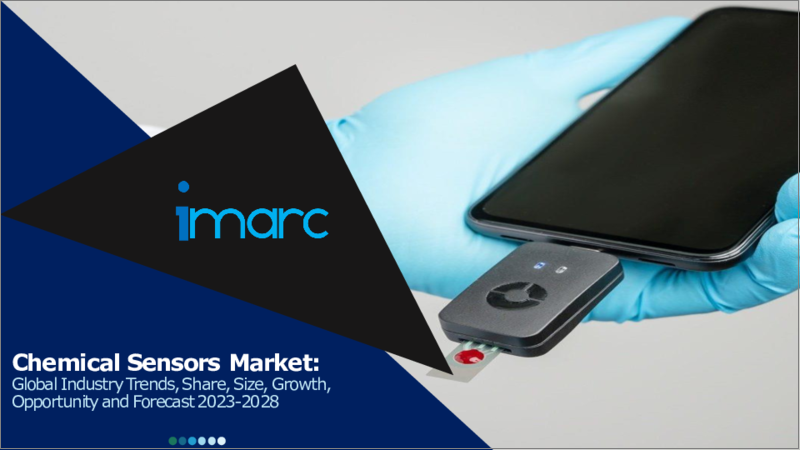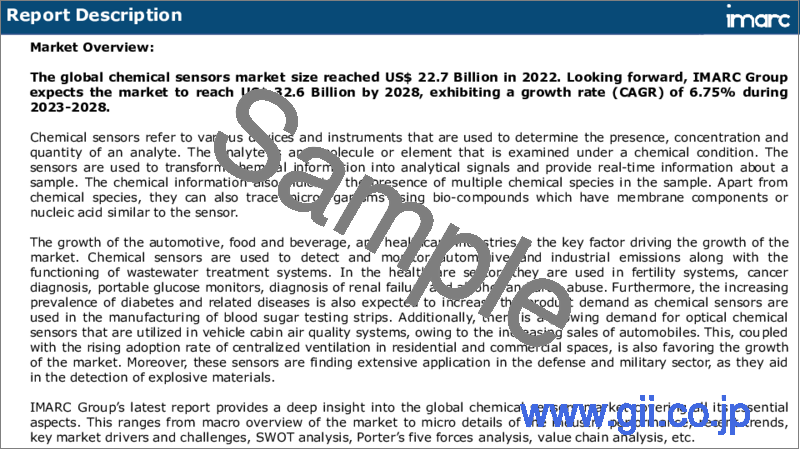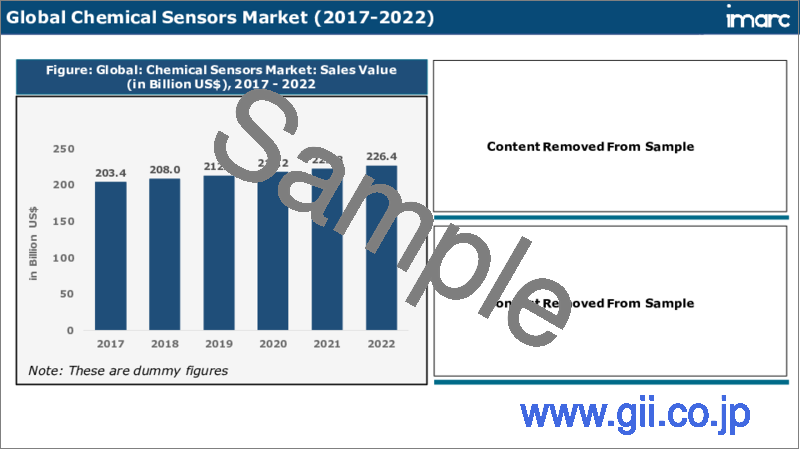|
|
市場調査レポート
商品コード
1287387
化学センサー市場:世界の産業動向、シェア、規模、成長機会、2023-2028年予測Chemical Sensors Market: Global Industry Trends, Share, Size, Growth, Opportunity and Forecast 2023-2028 |
||||||
|
● お客様のご希望に応じて、既存データの加工や未掲載情報(例:国別セグメント)の追加などの対応が可能です。 詳細はお問い合わせください。 |
|||||||
| 化学センサー市場:世界の産業動向、シェア、規模、成長機会、2023-2028年予測 |
|
出版日: 2023年03月18日
発行: IMARC
ページ情報: 英文 106 Pages
納期: 2~3営業日
|
- 全表示
- 概要
- 図表
- 目次
市場概要:
世界の化学センサーの市場規模は、2022年に227億米ドルに達しました。今後、IMARC Groupは、2023年から2028年の間に6.75%の成長率(CAGR)を示し、2028年までに326億米ドルに達すると予測しています。
化学センサーとは、被分析物の存在、濃度、量を測定するために使用される様々な装置や器具を指します。被分析物とは、化学的条件下で検査されるあらゆる分子や元素のことです。センサーは、化学情報を分析信号に変換し、サンプルに関する情報をリアルタイムで提供するために使用されます。また、化学情報は、試料中の複数の化学種の存在を示します。化学種以外にも、センサーと同様の膜成分や核酸を持つバイオ化合物を用いて、微生物を追跡することもできます。
自動車産業、飲食品産業、ヘルスケア産業の成長が、市場の成長を促進する主な要因となっています。化学センサーは、自動車や工業の排気ガスの検出や監視、排水処理システムの機能維持に使用されています。ヘルスケア分野では、不妊治療システム、がん診断、携帯型グルコースモニター、腎不全やアルコール・薬物乱用の診断に使用されています。さらに、血糖値測定用ストリップの製造に化学センサーが使用されていることから、糖尿病や関連疾患の有病率の増加も製品需要を増加させると予想されます。さらに、自動車の販売台数の増加に伴い、車内の空気清浄システムに使用される光学式化学センサーの需要も増加しています。また、住宅や商業施設における集中換気システムの導入率の上昇も、市場の成長を後押ししています。さらに、これらのセンサーは、爆発物の検知に役立つため、防衛・軍事分野でも広く応用されています。
IMARC Groupの最新レポートは、化学センサーの世界市場について、その重要な側面をすべて網羅した深い洞察を提供します。その内容は、市場のマクロな概要から、業界業績、最近の動向、市場促進要因・課題、SWOT分析、ポーターのファイブフォース分析、バリューチェーン分析などのミクロな詳細にまで及びます。本レポートは、業界関係者、投資家、研究者、コンサルタント、ビジネス戦略家、および何らかの形で化学センサー市場に参入している、または参入を計画しているすべての人々にとって必読の書です。
本レポートで回答した主な質問
- 化学センサーの世界市場はこれまでどのように推移し、今後数年間はどのように推移するのか?
- 化学センサーの世界市場における主要な地域市場はどこか?
- COVID-19は世界の化学センサー産業にどのような影響を与えたか?
- 製品タイプに基づく市場の内訳は?
- 分析対象物に基づく市場の内訳は?
- アプリケーションに基づく市場の内訳は?
- 世界の化学センサーのバリューチェーンにおける様々なステージは?
- 世界の化学センサーの主要な促進要因と課題は何か?
- 世界の化学センサーの産業構造と主要プレイヤーは?
- 世界の化学センサー産業における競合の程度はどの程度か?
目次
第1章 序文
第2章 調査範囲と調査手法
- 調査目的
- 利害関係者について
- データソース
- 一次情報
- 二次情報
- 市場推定
- ボトムアップアプローチ
- トップダウンアプローチ
- 予測手法
第3章 エグゼクティブサマリー
第4章 イントロダクション
- 概要
- 主要産業動向
第5章 化学センサーの世界市場
- 市場概要
- 市場実績
- COVID-19のインパクト
- 製品タイプ別市場内訳
- 分析対象別市場内訳
- アプリケーション別市場内訳
- 地域別市場内訳
- 市場予測
第6章 製品タイプ別市場内訳
- エレクトロケミカル
- 市場動向
- 主な種類
- ポテンショメトリック
- アンペロメトリック
- コンダクトメトリック
- その他
- 市場予測
- 光学
- 市場動向
- 主な種類
- 赤外
- 光電離
- その他
- 市場予測
- 触媒(ペリスター/ビーズ)
- 市場動向
- 市場予測
- 半導体
- 市場動向
- 市場予測
- その他
- 市場動向
- 市場予測
第7章 分析対象別市場内訳
- 固体
- 市場動向
- 市場予測
- 液体
- 市場動向
- 市場予測
- ガス
- 市場動向
- 市場予測
第8章 アプリケーション別市場内訳
- 産業
- 市場動向
- 主な種類
- 自動車
- 飲食品加工用
- 空調機器
- 市場予測
- 環境モニタリング
- 市場動向
- 主な種類
- 産業用安全・排出ガス
- 水・廃水
- 自動車排ガス試験
- 市場予測
- メディカル
- 市場動向
- 主な種類
- 臨床診断薬
- 栄養剤
- 市場予測
- 防衛・国土安全保障
- 市場動向
- 市場予測
- その他
- 市場動向
- 市場予測
第9章 地域別市場内訳
- アジア太平洋地域
- 市場動向
- 市場予測
- 欧州
- 市場動向
- 市場予測
- 北米
- 市場動向
- 市場予測
- 中東・アフリカ地域
- 市場動向
- 市場予測
- ラテンアメリカ
- 市場動向
- 市場予測
第10章 SWOT分析
- 概要
- 強み
- 弱み
- 機会
- 脅威
第11章 バリューチェーン分析
第12章 ポーターのファイブフォース分析
- 概要
- 買い手の交渉力
- 供給企業の交渉力
- 競合の度合い
- 新規参入業者の脅威
- 代替品の脅威
第13章 価格分析
第14章 競合情勢
- 市場構造
- 主要企業
- 主要企業のプロファイル
- Smiths Detection Inc.
- AirTest Technologies Inc.
- Hans Turck GmbH & Co. KG
- General Electric
- Thermo Fisher Scientific
- Bayer
- MSA Safety Incorporated
- Honeywell International Inc.
- Pepperl+Fuchs Group
- SICK AG
- Siemens AG
- ABB Ltd
- SenseAir AB
- Spectris PLC
- Denso Corporation
- Halma PLC
- Owlstone Inc.
List of Figures
- Figure 1: Global: Chemical Sensors Market: Major Drivers and Challenges
- Figure 2: Global: Chemical Sensors Market: Sales Value (in Billion US$), 2017-2022
- Figure 3: Global: Chemical Sensors Market: Breakup by Product Type (in %), 2022
- Figure 4: Global: Chemical Sensors Market: Breakup by Analyte (in %), 2022
- Figure 5: Global: Chemical Sensors Market: Breakup by Application (in %), 2022
- Figure 6: Global: Chemical Sensors Market: Breakup by Region (in %), 2022
- Figure 7: Global: Chemical Sensors Market Forecast: Sales Value (in Billion US$), 2023-2028
- Figure 8: Global: Chemical Sensors Industry: SWOT Analysis
- Figure 9: Global: Chemical Sensors Industry: Value Chain Analysis
- Figure 10: Global: Chemical Sensors Industry: Porter's Five Forces Analysis
- Figure 11: Global: Chemical Sensors (Electrochemical) Market: Sales Value (in Billion US$), 2017 & 2022
- Figure 12: Global: Chemical Sensors (Electrochemical) Market Forecast: Sales Value (in Billion US$), 2023-2028
- Figure 13: Global: Chemical Sensors (Optical) Market: Sales Value (in Billion US$), 2017 & 2022
- Figure 14: Global: Chemical Sensors (Optical) Market Forecast: Sales Value (in Billion US$), 2023-2028
- Figure 15: Global: Chemical Sensors (Pellistor/Catalytic Bead) Market: Sales Value (in Billion US$), 2017 & 2022
- Figure 16: Global: Chemical Sensors (Pellistor/Catalytic Bead) Market Forecast: Sales Value (in Billion US$), 2023-2028
- Figure 17: Global: Chemical Sensors (Semiconductor) Market: Sales Value (in Billion US$), 2017 & 2022
- Figure 18: Global: Chemical Sensors (Semiconductor) Market Forecast: Sales Value (in Billion US$), 2023-2028
- Figure 19: Global: Chemical Sensors (Other Product Types) Market: Sales Value (in Billion US$), 2017 & 2022
- Figure 20: Global: Chemical Sensors (Other Product Types) Market Forecast: Sales Value (in Billion US$), 2023-2028
- Figure 21: Global: Chemical Sensors (Solid) Market: Sales Value (in Billion US$), 2017 & 2022
- Figure 22: Global: Chemical Sensors (Solid) Market Forecast: Sales Value (in Billion US$), 2023-2028
- Figure 23: Global: Chemical Sensors (Liquid) Market: Sales Value (in Billion US$), 2017 & 2022
- Figure 24: Global: Chemical Sensors (Liquid) Market Forecast: Sales Value (in Billion US$), 2023-2028
- Figure 25: Global: Chemical Sensors (Gas) Market: Sales Value (in Billion US$), 2017 & 2022
- Figure 26: Global: Chemical Sensors (Gas) Market Forecast: Sales Value (in Billion US$), 2023-2028
- Figure 27: Global: Chemical Sensors (Industrial) Market: Sales Value (in Billion US$), 2017 & 2022
- Figure 28: Global: Chemical Sensors (Industrial) Market Forecast: Sales Value (in Billion US$), 2023-2028
- Figure 29: Global: Chemical Sensors (Environmental Monitoring) Market: Sales Value (in Billion US$), 2017 & 2022
- Figure 30: Global: Chemical Sensors (Environmental Monitoring) Market Forecast: Sales Value (in Billion US$), 2023-2028
- Figure 31: Global: Chemical Sensors (Medical) Market: Sales Value (in Billion US$), 2017 & 2022
- Figure 32: Global: Chemical Sensors (Medical) Market Forecast: Sales Value (in Billion US$), 2023-2028
- Figure 33: Global: Chemical Sensors (Defense and Homeland Security) Market: Sales Value (in Billion US$), 2017 & 2022
- Figure 34: Global: Chemical Sensors (Defense and Homeland Security) Market Forecast: Sales Value (in Billion US$), 2023-2028
- Figure 35: Global: Chemical Sensors (Other Applications) Market: Sales Value (in Billion US$), 2017 & 2022
- Figure 36: Global: Chemical Sensors (Other Applications) Market Forecast: Sales Value (in Billion US$), 2023-2028
- Figure 37: Asia Pacific: Chemical Sensors Market: Sales Value (in Billion US$), 2017 & 2022
- Figure 38: Asia Pacific: Chemical Sensors Market Forecast: Sales Value (in Billion US$), 2023-2028
- Figure 39: Europe: Chemical Sensors Market: Sales Value (in Billion US$), 2017 & 2022
- Figure 40: Europe: Chemical Sensors Market Forecast: Sales Value (in Billion US$), 2023-2028
- Figure 41: North America: Chemical Sensors Market: Sales Value (in Billion US$), 2017 & 2022
- Figure 42: North America: Chemical Sensors Market Forecast: Sales Value (in Billion US$), 2023-2028
- Figure 43: Middle East and Africa: Chemical Sensors Market: Sales Value (in Billion US$), 2017 & 2022
- Figure 44: Middle East and Africa: Chemical Sensors Market Forecast: Sales Value (in Billion US$), 2023-2028
- Figure 45: Latin America: Chemical Sensors Market: Sales Value (in Billion US$), 2017 & 2022
- Figure 46: Latin America: Chemical Sensors Market Forecast: Sales Value (in Billion US$), 2023-2028
List of Tables
- Table 1: Global: Chemical Sensors Market: Key Industry Highlights, 2022 and 2028
- Table 2: Global: Chemical Sensors Market Forecast: Breakup by Product Type (in Billion US$), 2023-2028
- Table 3: Global: Chemical Sensors Market Forecast: Breakup by Analyte (in Billion US$), 2023-2028
- Table 4: Global: Chemical Sensors Market Forecast: Breakup by Application (in Billion US$), 2023-2028
- Table 5: Global: Chemical Sensors Market Forecast: Breakup by Region (in Billion US$), 2023-2028
- Table 6: Global: Chemical Sensors Market Structure
- Table 7: Global: Chemical Sensors Market: Key Players
Market Overview:
The global chemical sensors market size reached US$ 22.7 Billion in 2022. Looking forward, IMARC Group expects the market to reach US$ 32.6 Billion by 2028, exhibiting a growth rate (CAGR) of 6.75% during 2023-2028.
Chemical sensors refer to various devices and instruments that are used to determine the presence, concentration and quantity of an analyte. The analyte is any molecule or element that is examined under a chemical condition. The sensors are used to transform chemical information into analytical signals and provide real-time information about a sample. The chemical information also indicates the presence of multiple chemical species in the sample. Apart from chemical species, they can also trace microorganisms using bio-compounds which have membrane components or nucleic acid similar to the sensor.
The growth of the automotive, food and beverage, and healthcare industries is the key factor driving the growth of the market. Chemical sensors are used to detect and monitor automotive and industrial emissions along with the functioning of wastewater treatment systems. In the healthcare sector, they are used in fertility systems, cancer diagnosis, portable glucose monitors, diagnosis of renal failure and alcohol and drug abuse. Furthermore, the increasing prevalence of diabetes and related diseases is also expected to increase the product demand as chemical sensors are used in the manufacturing of blood sugar testing strips. Additionally, there is a growing demand for optical chemical sensors that are utilized in vehicle cabin air quality systems, owing to the increasing sales of automobiles. This, coupled with the rising adoption rate of centralized ventilation in residential and commercial spaces, is also favoring the growth of the market. Moreover, these sensors are finding extensive application in the defense and military sector, as they aid in the detection of explosive materials.
IMARC Group's latest report provides a deep insight into the global chemical sensors market covering all its essential aspects. This ranges from macro overview of the market to micro details of the industry performance, recent trends, key market drivers and challenges, SWOT analysis, Porter's five forces analysis, value chain analysis, etc. This report is a must-read for industry players, investors, researchers, consultants, business strategists, and all those who have any kind of stake or are planning to foray into the chemical sensors market in any manner.
Key Market Segmentation:
IMARC Group provides an analysis of the key trends in each sub-segment of the global chemical sensors market report, along with forecasts at the global and regional level from 2023-2028. Our report has categorized the market based on product type, analyte and application.
Breakup by Product Type:
- Electrochemical
- Potentiometric
- Amperometric
- Conductometric
- Others
- Optical
- Infrared
- Photoionization
- Others
- Pellistor/Catalytic Bead
- Semiconductor
- Others
Based on the product type, the report finds that electrochemical sensors represent the most popular type of chemical sensors. Other major product types are pellistor/catalytic bead and semiconductor. Electrochemical sensors are further divided as potentiometric, amperometric, conductometric and others.
Breakup by Analyte:
- Solid
- Liquid
- Gas
On the basis of the analyte, the market has been categorized into solid, liquid and gas.
Breakup by Application:
- Industrial
- Motor Vehicles
- Food & Beverage Processing
- HVAC
- Environmental Monitoring
- Industrial Safety & Emissions
- Water & Wastewater
- Automotive Emissions Testing
- Medical
- Clinical Diagnostics
- Nutritional
- Defense and Homeland Security
- Others
The market has been segregated based on the application into industrial, environmental monitoring, medical, defense and homeland security and others. Amongst these, industrial applications represent the largest segment, which also includes motor vehicles, food and beverage processing and HVAC.
Breakup by Region:
- Asia Pacific
- Europe
- North America
- Middle East and Africa
- Latin America
On the basis of geography, North America enjoys the leading position in the market. Other major regions are Europe, Asia Pacific, Latin America, and Middle East and Africa.
Competitive Landscape:
The report has also analyzed the competitive landscape of the market with some of the key players being Smiths Detection Inc., AirTest Technologies Inc., Hans Turck GmbH & Co. KG, General Electric, Thermo Fisher Scientific, Bayer, MSA Safety Incorporated, Honeywell International Inc., Pepperl+Fuchs Group, SICK AG, Siemens AG, ABB Ltd, SenseAir AB, Spectris PLC, Denso Corporation, Halma PLC, Owlstone Inc., etc.
Key Questions Answered in This Report:
- How has the global chemical sensors market performed so far and how will it perform in the coming years?
- What are the key regional markets in the global chemical sensors industry?
- What has been the impact of COVID-19 on the global chemical sensors industry?
- What is the breakup of the market based on the product type?
- What is the breakup of the market based on the analyte?
- What is the breakup of the market based on the application?
- What are the various stages in the value chain of the global chemical sensors industry?
- What are the key driving factors and challenges in the global chemical sensors industry?
- What is the structure of the global chemical sensors industry and who are the key players?
- What is the degree of competition in the global chemical sensors industry?
Table of Contents
1 Preface
2 Scope and Methodology
- 2.1 Objectives of the Study
- 2.2 Stakeholders
- 2.3 Data Sources
- 2.3.1 Primary Sources
- 2.3.2 Secondary Sources
- 2.4 Market Estimation
- 2.4.1 Bottom-Up Approach
- 2.4.2 Top-Down Approach
- 2.5 Forecasting Methodology
3 Executive Summary
4 Introduction
- 4.1 Overview
- 4.2 Key Industry Trends
5 Global Chemical Sensors Market
- 5.1 Market Overview
- 5.2 Market Performance
- 5.3 Impact of COVID-19
- 5.4 Market Breakup by Product Type
- 5.5 Market Breakup by Analyte
- 5.6 Market Breakup by Application
- 5.7 Market Breakup by Region
- 5.8 Market Forecast
6 Market Breakup by Product Type
- 6.1 Electrochemical
- 6.1.1 Market Trends
- 6.1.2 Major Types
- 6.1.2.1 Potentiometric
- 6.1.2.2 Amperometric
- 6.1.2.3 Conductometric
- 6.1.2.4 Others
- 6.1.3 Market Forecast
- 6.2 Optical
- 6.2.1 Market Trends
- 6.2.2 Major Types
- 6.2.2.1 Infrared
- 6.2.2.2 Photoionization
- 6.2.2.3 Others
- 6.2.3 Market Forecast
- 6.3 Pellistor/Catalytic Bead
- 6.3.1 Market Trends
- 6.3.2 Market Forecast
- 6.4 Semiconductor
- 6.4.1 Market Trends
- 6.4.2 Market Forecast
- 6.5 Others
- 6.5.1 Market Trends
- 6.5.2 Market Forecast
7 Market Breakup by Analyte
- 7.1 Solid
- 7.1.1 Market Trends
- 7.1.2 Market Forecast
- 7.2 Liquid
- 7.2.1 Market Trends
- 7.2.2 Market Forecast
- 7.3 Gas
- 7.3.1 Market Trends
- 7.3.2 Market Forecast
8 Market Breakup by Application
- 8.1 Industrial
- 8.1.1 Market Trends
- 8.1.2 Major Types
- 8.1.2.1 Motor Vehicles
- 8.1.2.2 Food & Beverage Processing
- 8.1.2.3 HVAC
- 8.1.3 Market Forecast
- 8.2 Environmental Monitoring
- 8.2.1 Market Trends
- 8.2.2 Major Types
- 8.2.2.1 Industrial Safety & Emissions
- 8.2.2.2 Water & Wastewater
- 8.2.2.3 Automotive Emissions Testing
- 8.2.3 Market Forecast
- 8.3 Medical
- 8.3.1 Market Trends
- 8.3.2 Major Types
- 8.3.2.1 Clinical Diagnostics
- 8.3.2.2 Nutritional
- 8.3.3 Market Forecast
- 8.4 Defense and Homeland Security
- 8.4.1 Market Trends
- 8.4.2 Market Forecast
- 8.5 Others
- 8.5.1 Market Trends
- 8.5.2 Market Forecast
9 Market Breakup by Region
- 9.1 Asia Pacific
- 9.1.1 Market Trends
- 9.1.2 Market Forecast
- 9.2 Europe
- 9.2.1 Market Trends
- 9.2.2 Market Forecast
- 9.3 North America
- 9.3.1 Market Trends
- 9.3.2 Market Forecast
- 9.4 Middle East and Africa
- 9.4.1 Market Trends
- 9.4.2 Market Forecast
- 9.5 Latin America
- 9.5.1 Market Trends
- 9.5.2 Market Forecast
10 SWOT Analysis
- 10.1 Overview
- 10.2 Strengths
- 10.3 Weaknesses
- 10.4 Opportunities
- 10.5 Threats
11 Value Chain Analysis
12 Porter's Five Forces Analysis
- 12.1 Overview
- 12.2 Bargaining Power of Buyers
- 12.3 Bargaining Power of Suppliers
- 12.4 Degree of Competition
- 12.5 Threat of New Entrants
- 12.6 Threat of Substitutes
13 Price Analysis
14 Competitive Landscape
- 14.1 Market Structure
- 14.2 Key Players
- 14.3 Profiles of Key Players
- 14.3.1 Smiths Detection Inc.
- 14.3.2 AirTest Technologies Inc.
- 14.3.3 Hans Turck GmbH & Co. KG
- 14.3.4 General Electric
- 14.3.5 Thermo Fisher Scientific
- 14.3.6 Bayer
- 14.3.7 MSA Safety Incorporated
- 14.3.8 Honeywell International Inc.
- 14.3.9 Pepperl+Fuchs Group
- 14.3.10 SICK AG
- 14.3.11 Siemens AG
- 14.3.12 ABB Ltd
- 14.3.13 SenseAir AB
- 14.3.14 Spectris PLC
- 14.3.15 Denso Corporation
- 14.3.16 Halma PLC
- 14.3.17 Owlstone Inc.




